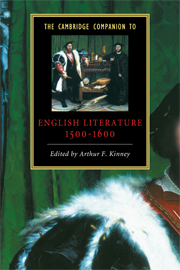Book contents
- Frontmatter
- 1 Introduction
- 2 The sixteenth century
- 3 Tudor aesthetics
- 4 Authorship and the material conditions of writing
- 5 Poetry, patronage, and the court
- 6 Religious writing
- 7 Dramatic experiments
- 8 Dramatic achievements
- 9 Lyric forms
- 10 Narrative, romance, and epic
- 11 The evolution of Tudor satire
- 12 Chronicles of private life
- 13 Popular culture in print
- 14 Rewriting the world, rewriting the body
- 15 Writing empire and nation
- Index
12 - Chronicles of private life
Published online by Cambridge University Press: 28 May 2006
- Frontmatter
- 1 Introduction
- 2 The sixteenth century
- 3 Tudor aesthetics
- 4 Authorship and the material conditions of writing
- 5 Poetry, patronage, and the court
- 6 Religious writing
- 7 Dramatic experiments
- 8 Dramatic achievements
- 9 Lyric forms
- 10 Narrative, romance, and epic
- 11 The evolution of Tudor satire
- 12 Chronicles of private life
- 13 Popular culture in print
- 14 Rewriting the world, rewriting the body
- 15 Writing empire and nation
- Index
Summary
The defining event of the sixteenth century was the Reformation. The break with Rome left its mark not only on the ecclesiastical, political, and economic spheres, but also on the private. Politically, the doctrine of the royal supremacy was advanced by the creation of an Anglican church headed by the English King. A principal way in which the monarchy justified its new power was through analogy to the “natural” structure of the private family: as the father was in his household, so the King was in his country, the uncontested center of authority. It was in the interest of the monarchy to produce an ideology which authorized the private household as the primary unit of social order and which reinforced the notion that the householder was absolute ruler within his household. Economically, repudiation of the Roman religion permitted the seizure of English lands and goods formerly held by churches, monasteries, and abbeys. The church had owned as much as a third of the country, and when the Crown not only appropriated these properties but also began to give them away and then sell them off, a relatively static land market exploded into activity.
- Type
- Chapter
- Information
- The Cambridge Companion to English Literature, 1500–1600 , pp. 241 - 264Publisher: Cambridge University PressPrint publication year: 1999
- 1
- Cited by



